C++ MyString
悲伤土豆拌饭 人气:0MyString的构造、析构、拷贝构造、赋值运算
class String
{
char* str;
public:
String(const char* p = NULL) :str(NULL)
{
if (p != NULL)
{
str = new char[strlen(p) + 1];//strlen()计算至'\0'截至的字符数
strcpy(str, p);
}
else
{
str = new char[1]; //额外提供一个空间
*str = '\0';
}
}
~String()
{
if (str != NULL)
{
delete[] str;
}
str = NULL;
}
//ostream& operator<<(const String* const this, ostream &out)
ostream& operator<<(ostream& out)const //重载插入操作符
{
if (str != NULL)
{
out << str;
}
return out;
}
String(const String& s):str(NULL)
{
//str = s.str; 浅拷贝 是同一个空间,会造成一个空间释放两次
//深拷贝
str = new char[strlen(s.str)+1];
strcpy(str, s.str);
}
String& operator=(const String& s)
{
if(this != &s)
{
delete[]str;
str = new char[strlen(s.str)+1]
strcpy(str,s.str);
}
return *this;
}
};
ostream& operator<<(ostream& out, const String& s)
{
s << out;
//s.operator<<(cout);
//operator<<(&s1,cout);
return out;
}
int main()
{
String s1("123");
s1 << cout;
//s1.operator<<(cout);
//operator<<(&s1,cout);
cout << s1 << endl;
//operator<<(cout, s1);
}
前面之所以对空指针构建对象提供一个空间的原因:使其在赋值重载中只有指向堆区一种情况进行处理
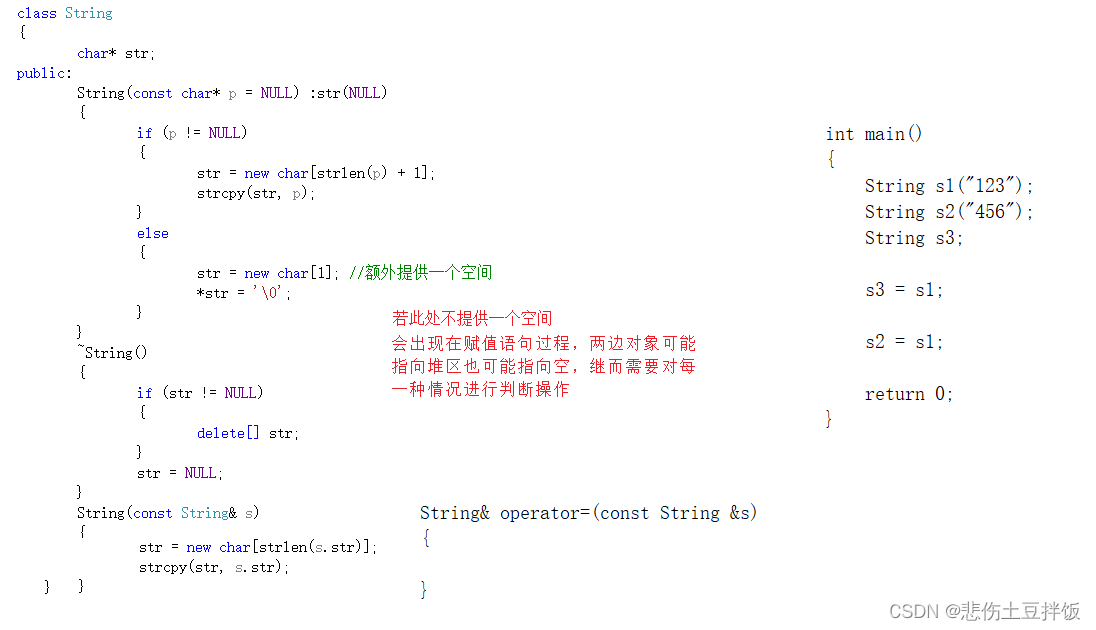
通过此方式进行等号运算符重载,然后调动拷贝构造对s2进行重写构造
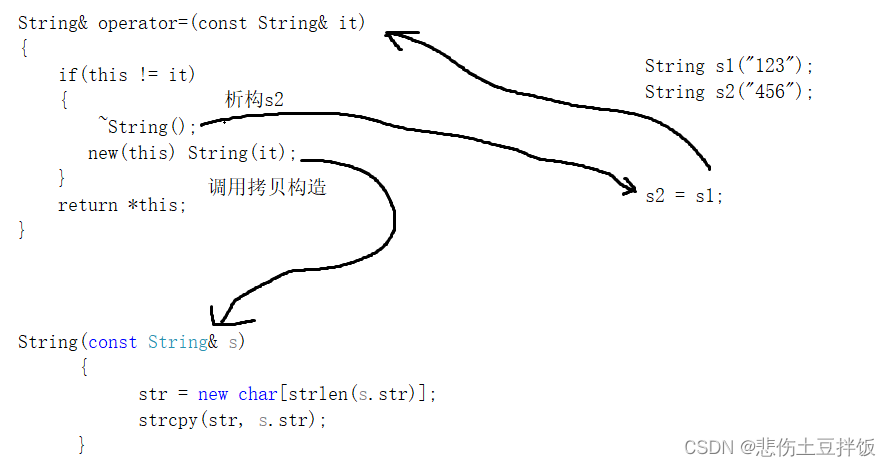
输出流重写
class String
{
char* str;
public:
String(const char* p = NULL) :str(NULL)
{
if (p != NULL)
{
str = new char[strlen(p) + 1];
strcpy(str, p);
}
else
{
str = new char[1]; //额外提供一个空间
*str = '\0';
}
}
~String()
{
if (str != NULL)
{
delete[] str;
}
str = NULL;
}
//ostream& operator<<(const String* const this, ostream &out)
ostream& operator<<(ostream& out)const //重载插入操作符
{
if (str != NULL)
{
out << str;
}
return out;
}
};
int main()
{
String s1("123");
s1 << cout;
//s1.operator<<(cout);
//operator<<(&s1,cout);
}
在这里通过改写前的代码 operator<<(&s1,cout); 不难看出,将cout初始化out,随后将this.str输出至out
ostream& operator<<(ostream& out)const
此处只能使用引用,因为cout在ostream类中进行转移,该类将拷贝构造函数定义为保护访问属性,无法使用cout初始化out,继而只能使用引用;同样若我们不想使用实参去初始化形参,可以将拷贝构造函数定义为私有或保护类型
若希望输出符合cout << s1 << endl;此种形式,需要再写一个全局函数
class String
{
char* str;
public:
String(const char* p = NULL) :str(NULL)
{
if (p != NULL)
{
str = new char[strlen(p) + 1];
strcpy(str, p);
}
else
{
str = new char[1]; //额外提供一个空间
*str = '\0';
}
}
~String()
{
if (str != NULL)
{
delete[] str;
}
str = NULL;
}
//ostream& operator<<(const String* const this, ostream &out)
ostream& operator<<(ostream& out)const //重载插入操作符
{
if (str != NULL)
{
out << str;
}
return out;
}
};
ostream& operator<<(ostream& out, const String& s)
{
s << out;
//s.operator<<(cout);
//operator<<(&s1,cout);
return out;
}
int main()
{
String s1("123");
s1 << cout;
//s1.operator<<(cout);
//operator<<(&s1,cout);
cout << s1 << endl;
//operator<<(cout, s1);
}
通过此种形式进行翻转,继而达到符合 cout << s1 << endl; 的形式
MyString加号运算符重载
int main()
{
String s1("123");
String s2("456");
String s3;
s3 = s1 + s2;
S3 = s1 + "789";
s3 = "789" + s1;
}
分别写三个加号运算符重载,来对应上面的三个情况(类+类、类+字符串、字符串+类)
String operator+(const String& s)const
{
char *p = new char(strlen(this->str) + strlen(s.str) + 1);
strcpy(p, this->str);
strcat(p, s.str);
return String(p);
}
第一个为成员函数,但是存在内存泄漏,需要进行下面的步骤
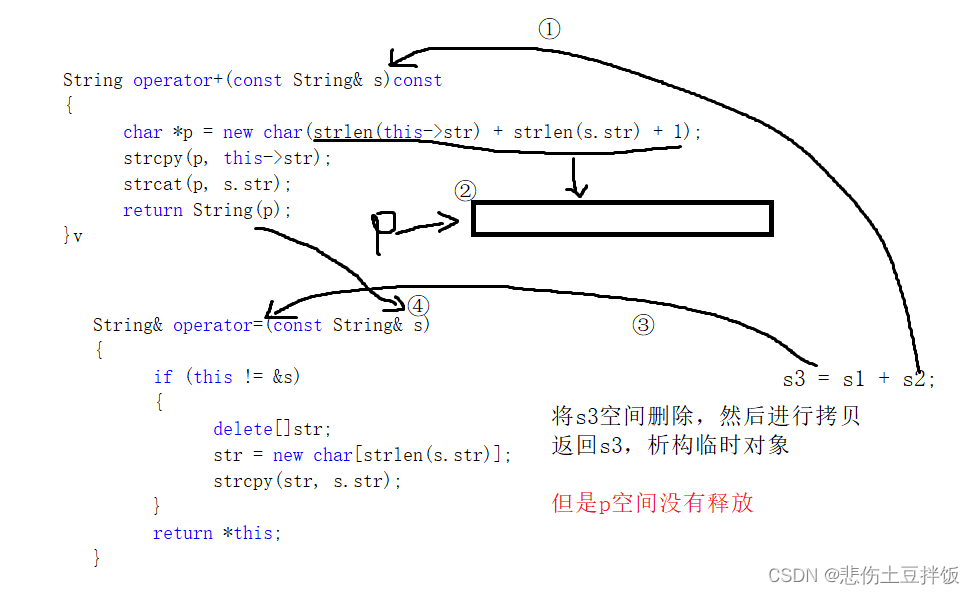
在私有成员变量中,创建一个新的构造函数,直接将p给到str,而没有创建新的空间;并且在加号运算符重载进行修改使其调用私有的构造函数
private:
String(char*p,int)//两个参数与公有构造区分
{
str = p;
}
public:
String operator+(const String& s)const
{
char *p = new char(strlen(this->str) + strlen(s.str) + 1);
strcpy(p, this->str);
strcat(p, s.str);
return String(p,1);
}
这样就解决了原本内存泄漏的问题
接下来完成剩余两个等号运算符重载
String operator+(const char* s)const
{
char* p = new char(strlen(this->str) + strlen(s) + 1);
strcpy(p, this->str);
strcat(p, s);
return String(p, 1);
//return *this + String(s)
//上面的方式更方便,但是会构造两个临时对象
}
此处需要写在类外,并且需要类内添加友元函数
friend String operator+(const char* t, const String s);
String operator+(const char* t, const String s)
{
char* p = new char(strlen(s.str) + strlen(t) + 1);
strcpy(p, s.str);
strcat(p, t);
return String(p, 1);
//return String(p) + s; 与上面同理,并且不需要友元函数
}
讨论一个衍生问题
class String
{
private:
char* str;
public:
String(const char* p = NULL) :str(NULL)
{
if (p != NULL)
{
str = new char[strlen(p) + 1];
strcpy(str, p);
}
else
{
str = new char[1]; //额外提供一个空间
*str = '\0';
}
}
~String()
{
if (str != NULL)
{
delete[] str;
}
str = NULL;
}
String(const String& s)
{
//str = s.str; 浅拷贝 是同一个空间,会造成一个空间释放两次
//深拷贝
str = new char[strlen(s.str)];
strcpy(str, s.str);
}
String& operator=(const String& s)
{
if (this != &s)
{
delete[]str;
str = new char[strlen(s.str)];
strcpy(str, s.str);
}
return *this;
}
};
String fun()
{
String s2("456");
return s2;
}
int main()
{
String s1;
s1 = fun();
return 0;
}
讨论此程序执行的过程总共创建了多少个对象:
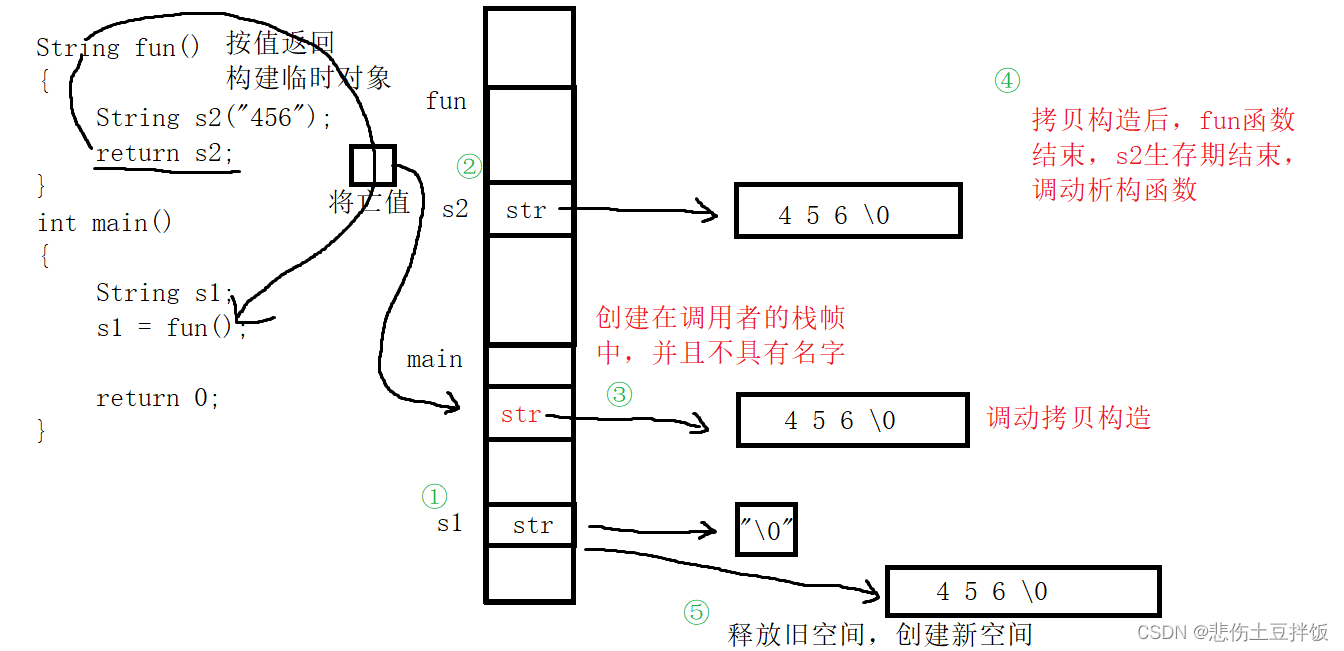
主函数运行首先开辟main函数栈帧,创建s1对象,默认构造只有大小为一的空间存放“\0”;之后执行fun()函数,分配fun栈帧,然后创建s2对象,创建一个堆区,str指向堆区空间;并且将按值返回,需要构建一个临时对象(将亡值);
将亡值概念:表达式过程中所产生的不具有名字的一个实体,叫做将亡值;将亡值的生存期仅在表达式的调用过程中,表达式调用结束,将亡值就会结束
构建临时对象调用拷贝构造,fun函数结束,s2生存期结束,调动析构函数;首先释放s2调用资源,再归还s2空间;回到主函数,把将亡值赋值给s1调用赋值语句,接着调用将亡值的析构函数进行释放
这个过程中总共创建了三个对象,分别是s1、s2、将亡值对象
那么如果我们对fun以引用进行返回
String& fun()
{
String s2("456");
return s2;
}
int main()
{
String s1;
s1 = fun();
return 0;
}
当以引用返回,就不会返回一个s2的备份,从引用底层来看会返回s2的地址;这样会从一个已死亡对象来获取数据,继而会得到随机值
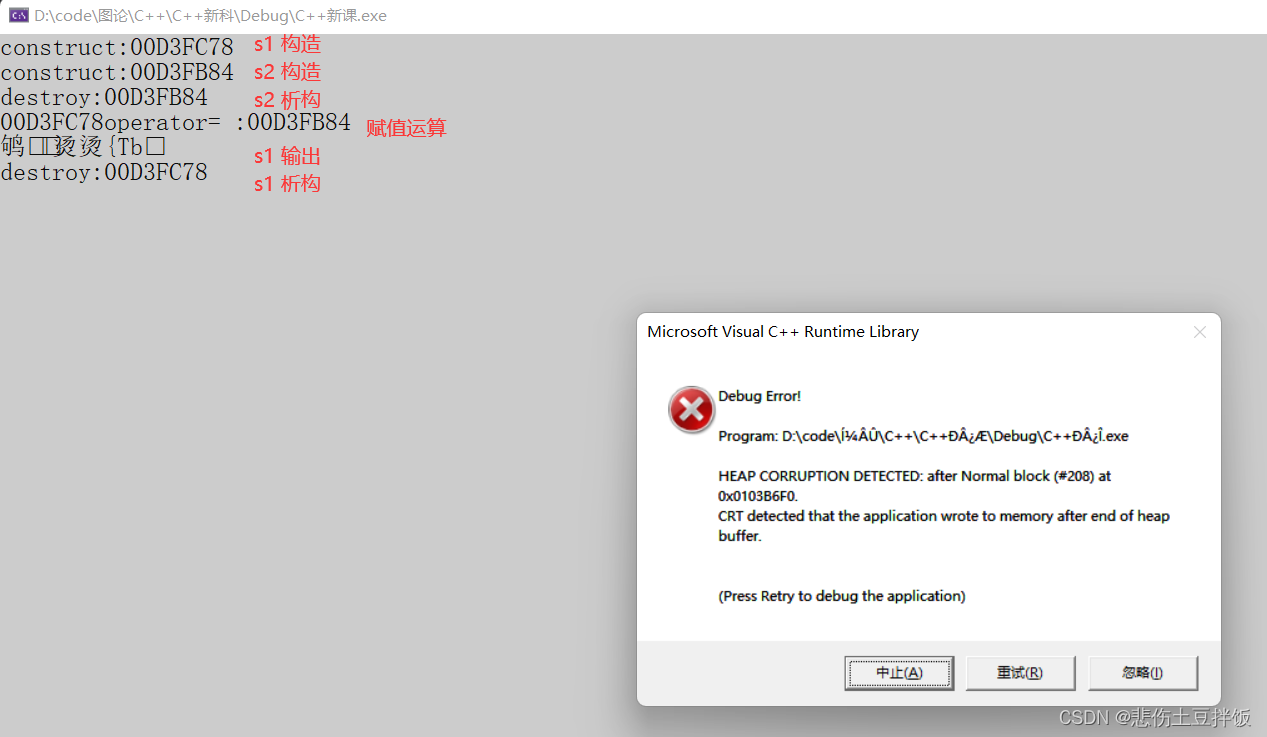
随后介绍的右值拷贝构造与右值赋值语句可以解决这个问题
加载全部内容